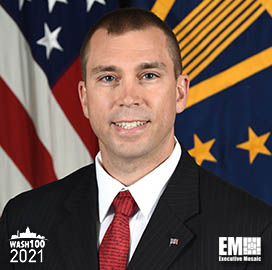Since its inception in 2019, the Space Development Agency (SDA) has continually worked to develop and modernize architecture concepts, systems designs, innovative technologies and emerging capabilities to enable leaders across the space domain to leverage next-generation space capabilities that increase warfighters’ lethality, maneuverability and survivability.
During Potomac Officers Club’s 2021 SDA Forum, notable public and private sector leaders joined together to address the latest initiatives, efficiencies and challenges facing the nation, as we compete to maintain space superiority.
Dr. Derek Tournear, director of the SDA within the U.S. Department of Defense (DoD) served as the Forum’s opening keynote speaker. He addressed advancements and challenges within the development and delivery of innovative space solutions, as well as how industry can support SDA initiatives.
If you missed the 2021 SDA Forum, you can still register to watch the OnDemand Version by visiting Potomac Officers Club’s Event Archive.
Following his introduction by Kay Sears, vice president and general manager of Military Space with Lockheed Martin, Tournear took the virtual stage to address SDA’s emerging technologies and capabilities. “Interoperability is critical to stay ahead of the curve of our adversaries,” Sears said.
Tournear discussed SDA’s initial products, which feature two main capabilities: beyond line of sight targeting and detection of land and maritime targets, and tracking and targeting of advanced missile threats. “SDA was established to be a constructive disrupter within the department,” Tournear said.
The SDA has two main pillars, including proliferation of satellites and spiral development to field new capabilities to launch new tranches every two years. Tournear noted that in 2021, SDA will do risk reduction demos with the Air Force Research Laboratory (AFRL) and DARPA.
The agency will launch four satellites in June 2021, which will demonstrate elements of the optical mesh network. He noted that the satellite constellation will enable data transport, and serves as the backbone to its mission. It will also provide low latency communication.
Tournear said that Tranche 0 will launch 20 network satellites, as well as 8 wide field of view OPIR satellites to demonstrate tracking missions. MDA will also launch two medium field of view satellites. In Tranche 1, SDA plans to launch up to 150 satellites to build out the initial operating capability.
“SDA works to meet the needs of the warfighters. We are developing products in a spiral mindset, which is then going to be used by the customer. We want to make sure we can address their needs without following the standards of incremental innovation,” Tournear added.
Following Tournear’s address, the forum featured an expert panel, hosting Dr. Frank Turner, CDR Damon Melidossian and John London of SDA, as well as Lt Col. Tim Trimailo of the Space & Missile Systems Center. The panel was moderated by Stacy Kubicek, vice president and general manager of Mission Solutions with Lockheed Martin.
The panelists discussed SDA’s evolution to date, as well as to how the government and industry work together to deliver the best technologies, so the nation can maintain its advantage in the modern space race.
To hear Tournear’s complete keynote address, as well as the expert panel discussion that followed his remarks, visit Potomac Officers Club’s Event Archive to register for the OnDemand footage.

Mark your calendars for March 23rd, when Potomac Officers Club will host its 2021 Industrial Space Defense Summit. Gen. John Raymond, chief of Space Operations with the U.S. Space Force and 2021 Wash100 Award recipient, will serve as a keynote speaker during the Summit. He will address space technology, innovation and private-public partnerships that will expand federal space defense capabilities and help defeat adversaries.




